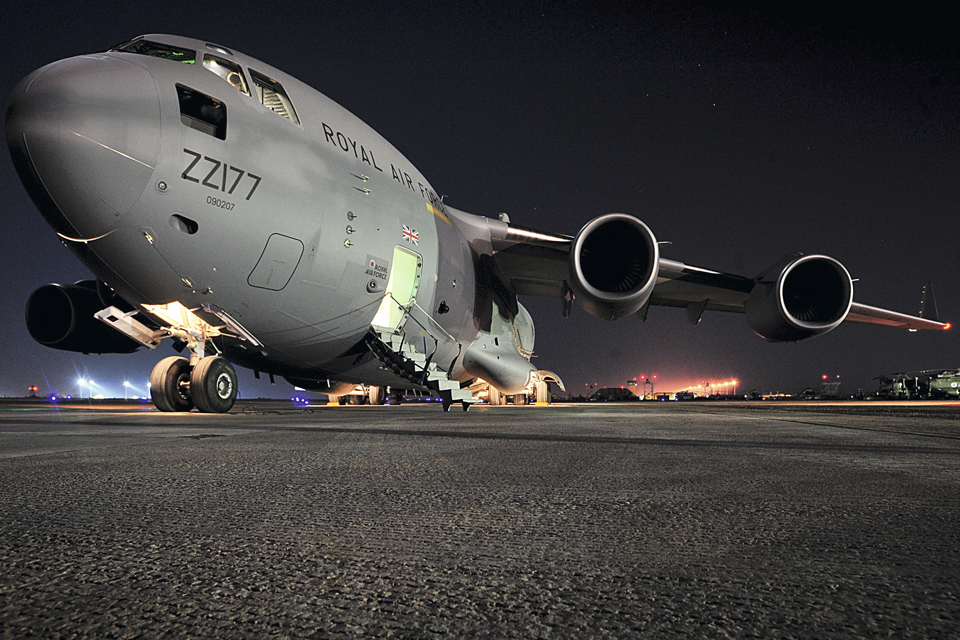RAF evacuates Britons from South Sudan
RAF aircrew made a daring precision landing at an airfield in South Sudan to rescue British citizens fleeing turmoil in the African state.
![A Royal Air Force C-17 Globemaster aircraft at RAF Brize Norton (library image) [Picture: Senior Aircraftman Neil Chapman, Crown copyright]](https://assets.publishing.service.gov.uk/media/5a61b5d240f0b60abc675172/s300_45150440g.jpg)
A Royal Air Force C-17 Globemaster aircraft
The pilot of a giant C-17 Globemaster aircraft safely touched down earlier today (Thursday) despite a crashed civilian airliner obstructing the runway.
At just after 3am the 266 tonne transport took off from RAF Brize Norton in Oxfordshire at the request of the Foreign and Commonwealth Office (FCO) who are co-ordinating the evacuation of UK nationals and others.
However, after a 9-hour flight, covering nearly 3,500 miles, the aircrew faced an unexpected challenge when approaching the airport at the South Sudanese capital Juba.
Earlier, a civilian 737 airliner had slewed to a halt 2 thirds of the way down the runway after its nose wheel collapsed.
The crashed aircraft was in the process of being made safe by airport emergency services as the RAF C-17 made its approach.

A Royal Air Force C-17 Globemaster aircraft photographed during an international operation (library image) [Picture: Corporal Mark Webster, Crown copyright]
Officer Commanding 99 Squadron, Wing Commander Stuart Lindsell, said:
We practice short landings in training but getting down on a runway with a crashed aircraft taking up a large part of it would really concentrate the mind and is way outside what we would normally expect.
I think it’s fair to say that this C17 captain and his crew have had 1 of the toughest days anyone on this squadron has had since we were stood up 12 years ago.
It’s not just the aircrew but the RAF Regiment who provided protection on the ground, the movers who helped get the passengers on board, the medics and the engineers, all of them have all performed brilliantly and I’m extremely proud of them.
Wing Commander Lindsell, himself a C 17 pilot, said 99 Squadron were used to being on high alert but that the South Sudan mission had come at very short notice with the aircraft successfully completing its first flight within 24 hours of the order being issued.

A Royal Air Force C-17 Globemaster aircraft photographed at Evreux Airbase near Paris, France, before embarking French equipment and troops to deploy to Mali, Africa, earlier this year [Picture: Senior Aircraftman Dek Traylor, Crown copyright]
On board the RAF aircraft were medics, force protection and air movements personnel, and FCO officials whose job was to assist people wanting to leave the country.
The C-17 is designed to carry out high angle, steep approaches at relatively slow speeds, which allows it to operate into small airfields in austere conditions with short, narrow runways.
These capabilities, and its long range, make it ideal for humanitarian missions which it has proved in the past year delivering aid to Typhoon victims in the Philippines and transporting military equipment to Mali and the Central African Republic.
The aircraft picked up 182 passengers including Britons, Commonwealth and EU citizens, who were quickly loaded before the short onward flight to Entebbe in Uganda.
The RAF’s Chief of Staff for Operations, Air Vice-Marshal Sean Reynolds, said:
This again demonstrates the Royal Air Force’s ability to react swiftly and effectively to protect and assist British people worldwide.
Throughout 2013, wherever there has been an issue demanding a UK response, there has been an RAF aircraft.
Updates to this page
-
A second C-17 has collected more passengers to transport them to Entebbe
-
First published.